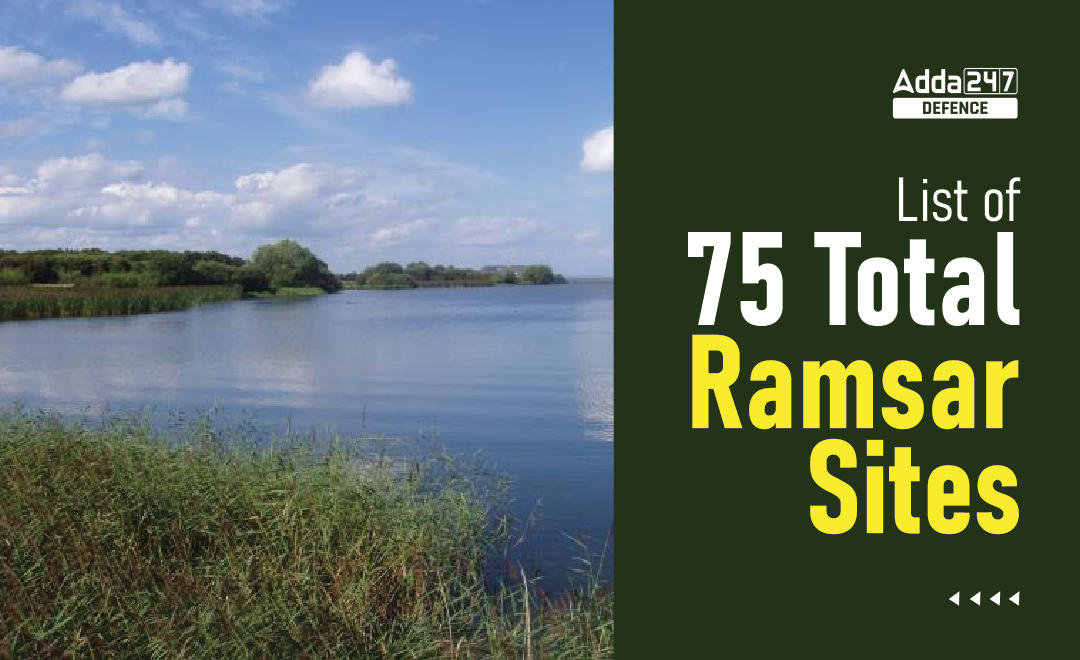Ramsar Sites in India
India has recently added 11 new wetlands to the list of Ramsar sites, and with that, the total number of Ramsar sites in India has reached to total of 75 Ramsar sites. All these sites cover a total area of 13,26,677 hectares in the country on the year when India marks its 77th year of Independence.
India became one of the signatories of the Ramsar Convention on 1st Feb 1982 which was earlier taken place in Ramsar, Iran, in 1971. A total of 26 sites were added to the list of Ramsar sites from 1982 to 2013, however, 49 new wetlands were added to the list of Ramsar sites in India from 2014 to 2022 and now in 2022, a total of 28 sites have been added to the list of Ramsar sites in India. Tamil Nadu has a maximum no. of Ramsar sites (14 number), followed by UP which has 10 nos. of Ramsar sites.
What are Ramsar Sites?
A Ramsar site is a wetland site which has given international importance as per the ‘Ramsar Convention’. or ‘Convention on Wetlands’. It is an international established by UNESCO, a treaty for the conservation and sustainable use of Ramsar sites. It came into force in 1975.
The Ramsar convention has been given its name after the city where it took place in 1971, which is Ramsar in Iran. Giving the status of the Ramsar Site helps in the protection and management of wetlands and justified use of their resources. As per the latest data, There are a total of 171 signatories nation to the convention and India became one of them on February 1, 1982.
The Ramsar Convention on Wetlands defines wetlands as “areas of marsh, fen, peat land or water, whether natural or artificial, permanent or temporary, with water that is static or flowing, fresh, brackish or salt, including areas of marine water the depth of which at low tide does not exceed six meters.”
The mission which has been decided by the Convention is “the conservation and wise use of all wetlands through local and national actions and international cooperation, as a contribution towards achieving sustainable development throughout the world”.
List of 75 Total Ramsar Sites in India
India is home to a diverse range of wetlands that provide vital ecosystem services, including water supply, flood control, and biodiversity conservation. Many of these wetlands have been designated as Ramsar Sites, which are recognized under the Ramsar Convention on Wetlands of International Importance. India has a total of 75 Ramsar Sites. Check the list given below –
| Serial no | Name of the Ramsar Site | State | Area (sq Km) |
|---|---|---|---|
| 1 | Kolleru Lake | Andhra Pradesh | 901 |
| 2 | Deepor Beel | Assam | 40 |
| 3 | Kabartal Wetland | Bihar | 26.20 |
| 4 | Khijadia Wildlife Sanctuary | Gujarat | 5.12 |
| 5 | Nalsarovar Bird Sanctuary | Gujarat | 120 |
| 6 | Thol Lake Wildlife Sanctuary | Gujarat | 6.99 |
| 7 | Wadhvana Wetland | Gujarat | 6.30 |
| 8 | Bhindawas Wildlife Sanctuary | Haryana | 4.12 |
| 9 | Sultanpur National Park | Haryana | 1.425 |
| 10 | Chandertal Wetland | Himachal Pradesh | 0.49 |
| 11 | Pong Dam Lake | Himachal Pradesh | 156.62 |
| 12 | Renuka Wetland | Himachal Pradesh | 0.2 |
| 13 | Wular Lake | Jammu & Kashmir | 189 |
| 14 | Hokera Wetland | Jammu and Kashmir | 13.75 |
| 15 | Surinsar-Mansar Lakes | Jammu and Kashmir | 3.5 |
| 16 | Tsomoriri Lake | UT of Ladakh | 120 |
| 17 | Asthamudi Wetland | Kerala | 614 |
| 18 | Sasthamkotta Lake | Kerala | 3.73 |
| 19 | Vembanad Kol Wetland | Kerala | 1512.5 |
| 20 | Tso Kar Wetland Complex | Ladakh | 95.77 |
| 21 | Bhoj Wetlands | Madhya Pradesh | 32.01 |
| 22 | Lonar Lake | Maharashtra | 4.27 |
| 23 | Nandur Madhameshwar | Maharashtra | 14.37 |
| 24 | Loktak Lake | Manipur | 266 |
| 25 | Bhitarkanika Mangroves | Orissa | 650 |
| 26 | Chilka Lake | Orissa | 1165 |
| 27 | Beas Conservation Reserve | Punjab | 64.289 |
| 28 | Harike Lake | Punjab | 41 |
| 29 | Kanjli Lake | Punjab | 1.83 |
| 30 | Keshopur-Miani Community Reserve | Punjab | 3.439 |
| 31 | Nangal Wildlife Sanctuary | Punjab | 1.16 |
| 32 | Ropar Lake | Punjab | 13.65 |
| 33 | Keoladeo Ghana NP | Rajasthan | 28.73 |
| 34 | Sambhar Lake | Rajasthan | 240 |
| 35 | Point Calimere Wildlife and Bird Sanctuary | Tamil Nadu | 385 |
| 36 | Rudrasagar Lake | Tripura | 2.4 |
| 37 | Bakhira Wildlife Sanctuary | Uttar Pradesh | 28.94 |
| 38 | Haiderpur Wetland | Uttar Pradesh | 69.08 |
| 39 | Nawabganj Bird Sanctuary | Uttar Pradesh | 2.246 |
| 40 | Parvati Agra Bird Sanctuary | Uttar Pradesh | 7.22 |
| 41 | Saman Bird Sanctuary | Uttar Pradesh | 52.63 |
| 42 | Samaspur Bird Sanctuary | Uttar Pradesh | 79.94 |
| 43 | Sandi Bird Sanctuary | Uttar Pradesh | 30.85 |
| 44 | Sarsai Nawar Jheel | Uttar Pradesh | 16.13 |
| 45 | Sur Sarovar | Uttar Pradesh | 4.31 |
| 46 | Upper Ganga River (Brijghat to Narora Stretch) | Uttar Pradesh | 265.9 |
| 47 | Asan Conservation Reserve | Uttarakhand | 4.444 |
| 48 | East Kolkata Wetlands | West Bengal | 125 |
| 49 | Sunderbans Wetland | West Bengal | 4230 |
| 50 | Karikili Bird Sanctuary | TN | 0.58442 |
| 51 | Pallikaranai Marsh Reserve Forest | TN | 12.47537 |
| 52 | Pichavaram Mangrove | TN | 14.78642 |
| 53 | Pala wetland | Mizoram | 18.5 |
| 54 | Sakhya Sagar | MP | 2.48 |
| 55 | Sirpur Wetland | Madhya Pradesh | 1.61 |
| 56 | Ranganathittu Bird Sanctuary | Karnataka | 5.177 |
| 57 | Nanda Lake | Goa | 0.4201 |
| 58 | Satkosia Gorge | Odisha | 981.9672 |
| 59 | Udhayamarthandapuram Bird Sanctuary | Tamil Nadu | 0.4377 |
| 60 | Vedanthangal Bird Sanctuary | Tamil Nadu | 0.4035 |
| 61 | Vellode Bird Sanctuary | Tamil Nadu | 0.7719 |
| 62 | Vembannur Wetland Complex | Tamil Nadu | 0.1975 |
| 63 | Gulf of Mannar Marine Biosphere Reserve | Tamil Nadu | 526.71876 |
| 64 | Koothankulam Bird Sanctuary | Tamil Nadu | 0.7204 |
| 65 | Tampara Lake | Odisha | 654 |
| 66 | Hirakud Reservoir | Odisha | 2.31 |
| 67 | Ansupa Lake | Odisha | 8.22 |
| 68 | Yashwant Sagar | Madhya Pradesh | 2.60 |
| 69 | Chitrangudi Bird Sanctuary | Tamil Nadu | 0.94 |
| 70 | Suchindram Theroor Wetland Complex | Tamil Nadu | 1.12 |
| 71 | Vaduvur Bird Sanctuary | Tamil Nadu | 0.96 |
| 72 | Kanjirankulam Bird Sanctuary | Tamil Nadu | 65.21 |
| 73 | Thane Creek | Maharashtra | 48.12 |
| 74 | Hygam Wetland Conservation Reserve | Jammu and Kashmir | 8.01 |
| 75 | Shallbugh Wetland Conservation Reserve | Jammu and Kashmir | 16.75 |
Ramsar Sites in India represent some of the most ecologically significant wetlands in the world. These sites not only provide vital ecosystem services but also play a crucial role in conserving India’s rich biodiversity. It is imperative that these wetlands receive the necessary protection and management to ensure their long-term sustainability.
New Ramsar Sites in India
India is indeed known for its rich biodiversity and is home to several ecologically significant wetlands that have been designated as Ramsar sites. The Ramsar Convention is an international treaty signed in 1971, aimed at the conservation and sustainable use of wetlands worldwide. Wetlands are crucial ecosystems that provide various ecological services, including habitat for diverse plant and animal species, water purification, flood control, and support for local communities.
Given below are the latest Ramsar Sites in India:
- Tampara Lake in Odisha
- Hirakud Reservoir in Odisha.
- Ansupa Lake, also located in Odisha
- Yashwant Sagar in Odisha
- The Chitrangudi Bird Sanctuary in Madhya Pradesh
- Suchindram Theroor Wetland Complex in Tamil Nadu.
- The Vaduvur Bird Sanctuary in Tamil Nadu
- Kanjirankulam Bird Sanctuary, situated in Tamil Nadu
- Thane Creek in Maharashtra has received Ramsar Site status.
- The Hygam Wetland Conservation Reserve in Jammu and Kashmir
- Shallbugh Wetland Conservation Reserve in Jammu and Kashmir.
Some Important Facts About Ramsar Sites
Ramsar sites are designated as wetlands of international importance under the Ramsar Convention, an intergovernmental environmental treaty adopted in 1971. They are crucial for conserving biodiversity and providing essential ecosystem services. As of today, there are over 2,400 Ramsar sites worldwide, covering an impressive 2.5 million square kilometers. These protected areas encompass a wide range of wetland types, from marshes and swamps to lakes and rivers.
- The very first Ramsar site, designated in 1974, is the Cobourg Peninsula in Australia. This remarkable site is home to a diverse array of wildlife, including migratory birds, turtles, and marine mammals.
- The United Kingdom boasts the largest number of Ramsar sites globally, with an impressive 175 sites. This reflects the country’s strong commitment to protecting its wetlands and the valuable services they provide.
- Every year on February 2, we celebrate International Wetlands Day, commemorating the signing of the Ramsar Convention on that date in 1971. This day serves as an important reminder of the critical role wetlands play in maintaining healthy ecosystems and supporting human well-being.
- The Ramsar Convention collaborates with several organizations to achieve its conservation goals. These partners include:
- International Union for Conservation of Nature (IUCN): A leading global organization dedicated to nature conservation and sustainable development.
- BirdLife International: The world’s largest conservation organization focused on birds and their habitats.
- International Water Management Institute (IWMI): A non-profit research institute that addresses water management challenges in developing countries.
- Wetlands International: A global organization working to conserve and restore wetlands for the benefit of people and nature.
- Wildfowl & Wetlands Trust (WWT): A UK-based charity dedicated to protecting wetland habitats and the wildlife they support.
- WWF International: The world’s leading conservation organization, working to conserve nature and reduce the most pressing threats to the diversity of life on Earth.
Also Check:



 Important Topics to Score 300+ in NDA GA...
Important Topics to Score 300+ in NDA GA...
 NDA Exam Pattern 2025 for GAT and Maths
NDA Exam Pattern 2025 for GAT and Maths
 How to Crack NDA Exam in the First Attem...
How to Crack NDA Exam in the First Attem...
